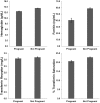Iron status and reproduction in US women: National Health and Nutrition Examination Survey, 1999-2006
- PMID: 25375360
- PMCID: PMC4223055
- DOI: 10.1371/journal.pone.0112216
Iron status and reproduction in US women: National Health and Nutrition Examination Survey, 1999-2006
Abstract
Women experience significant changes in iron status throughout their reproductive lifespans. While this is evident in regions with high rates of malnutrition and infectious disease, the extent of reproductive-related changes is less well known in countries with low rates of iron deficiency anemia, such as the United States. The goal of this study is determine the relationship between women's reproductive variables (pregnancy, parity, currently breastfeeding, regular menstruation, hormonal contraceptive use, and age at menarche) and iron status (hemoglobin, ferritin, transferrin receptor, and % transferrin saturation) using an anthropological framework for interpreting the results. Data from women aged 18-49 were taken from the 1999-2006 US NHANES, a nationally representative cross-sectional sample of US women. Using multiple imputation and complex survey statistics, women's reproductive variables were regressed against indicators of iron status. Pregnant women had significantly poorer iron status, by most indicators, than non-pregnant women. All biomarkers demonstrated significantly lower iron levels with increasing parity. Women who were having regular periods had iron indicators that suggested decreased iron levels, while women who used hormonal contraceptives had iron indicators that suggested increased iron levels. Despite relatively good iron status and widespread availability of iron-rich foods in the US, women still exhibit patterns of iron depletion across several reproductive variables of interest. These results contribute to an ecological approach to iron status that seeks to understand variation in iron status, with the hopes that appropriate, population-specific recommendations can be developed to improve women's health.
Conflict of interest statement
Figures
Similar articles
-
Assessment of iron status in US pregnant women from the National Health and Nutrition Examination Survey (NHANES), 1999-2006.Am J Clin Nutr. 2011 Jun;93(6):1312-20. doi: 10.3945/ajcn.110.007195. Epub 2011 Mar 23. Am J Clin Nutr. 2011. PMID: 21430118
-
Iron status markers, serum ferritin and hemoglobin in 1359 Danish women in relation to menstruation, hormonal contraception, parity, and postmenopausal hormone treatment.Ann Hematol. 1992 Aug;65(2):96-102. doi: 10.1007/BF01698138. Ann Hematol. 1992. PMID: 1511065
-
Iron deficiency is associated with food insecurity in pregnant females in the United States: National Health and Nutrition Examination Survey 1999-2010.J Acad Nutr Diet. 2014 Dec;114(12):1967-73. doi: 10.1016/j.jand.2014.04.025. Epub 2014 Jun 20. J Acad Nutr Diet. 2014. PMID: 24953790
-
Iron deficiency: assessment during pregnancy and its importance in pregnant adolescents.Am J Clin Nutr. 1994 Feb;59(2 Suppl):502S-508S discussion 508S-510S. doi: 10.1093/ajcn/59.2.502S. Am J Clin Nutr. 1994. PMID: 8304288 Review.
-
[Review by expert group in the diagnosis and treatment of anemia in pregnant women. Federación Mexicana de Colegios de Obstetricia y Ginecología].Ginecol Obstet Mex. 2012 Sep;80(9):563-80. Ginecol Obstet Mex. 2012. PMID: 23243836 Spanish.
Cited by
-
Characterization of pubertal development of girls in rural Bangladesh.PLoS One. 2021 Apr 2;16(4):e0247762. doi: 10.1371/journal.pone.0247762. eCollection 2021. PLoS One. 2021. PMID: 33798230 Free PMC article.
-
Priority Micronutrient Density in Foods.Front Nutr. 2022 Mar 7;9:806566. doi: 10.3389/fnut.2022.806566. eCollection 2022. Front Nutr. 2022. PMID: 35321287 Free PMC article.
-
Iron Deficiency and Iron Deficiency Anemia Are Common Epidemiological Conditions in Saudi Arabia: Report of the National Epidemiological Survey.Anemia. 2020 Dec 29;2020:6642568. doi: 10.1155/2020/6642568. eCollection 2020. Anemia. 2020. PMID: 33936813 Free PMC article.
-
Prevalence of postpartum anaemia and iron deficiency by serum ferritin, soluble transferrin receptor and total body iron, and associations with ethnicity and clinical factors: a Norwegian population-based cohort study.J Nutr Sci. 2022 Jun 13;11:e46. doi: 10.1017/jns.2022.45. eCollection 2022. J Nutr Sci. 2022. PMID: 35754987 Free PMC article.
-
Hemoglobin concentration and incident metabolic syndrome: a population-based large-scale cohort study.Endocrine. 2015 Nov;50(2):390-6. doi: 10.1007/s12020-015-0587-9. Epub 2015 Apr 12. Endocrine. 2015. PMID: 25863486
References
-
- Balarajan Y, Ramakrishnan U, Özaltin E, Shankar AH, Subramanian SV (2011) Anaemia in low-income and middle-income countries. Lancet 378: 2123–2135. - PubMed
-
- Cao C, O'Brien KO (2013) Pregnancy and iron homeostasis: an update. Nutr Rev 71: 35–51. - PubMed
-
- Allen LH (2000) Anemia and iron deficiency: effects on pregnancy outcome. Am J Clin Nutr 71: 1280s–1284s. - PubMed
-
- Milman N (2006) Iron and pregnancy: A delicate balance. Ann Hematol 85: 559–565. - PubMed
MeSH terms
Substances
LinkOut - more resources
Full Text Sources
Other Literature Sources
Medical



